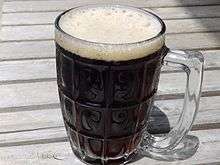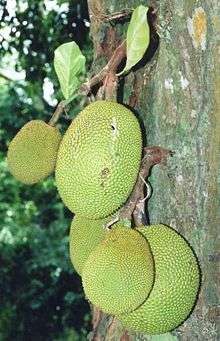Root beer

Root beer is a sweet soda traditionally made using the Sassafras tree Sassafras albidum (sassafras) or the vine Smilax ornata (sarsaparilla) as the primary flavor. Root beer may be alcoholic or non-alcoholic, come naturally decaffeinated or have caffeine added, and may be carbonated or non-carbonated. Root beer usually has a thick foamy head when poured. Modern, commercially produced root beer is generally sweet, foamy, carbonated, non-alcoholic, and is flavoured using artificial sassafras flavouring. Sassafras root is still used to flavor traditional root beer, although since sassafras was banned by the FDA because of the carcinogenicity of its constituent safrole, most commercial recipes do not contain sassafras.[1][2] Some commercial root beers do use a safrole-free sassafras extract.[3]
History
Sassafras root beverages were made by Native Americans for culinary and medicinal reasons before the arrival of Europeans in North America, but European culinary techniques have been applied to making traditional sassafras-based beverages similar to root beer since the 16th and 17th centuries. Root beer was sold in confectionery stores since the 1840s, and written recipes for root beer have been documented since the 1860s. It is possible that it was combined with soda as early as the 1850s, and root beer sold in stores was most often sold as a syrup rather than a ready-made beverage.[4] The tradition of brewing root beer is thought to have evolved out of other small beer traditions that produced fermented drinks with very low alcohol content that were thought to be healthier to drink than possibly tainted local sources of drinking water, and enhanced by the medicinal and nutritional qualities of the ingredients used. Beyond its aromatic qualities, the medicinal benefits of sassafras were well known to both Native Americans and Europeans, and druggists began marketing root beer for its medicinal qualities.[5]

Pharmacist Charles Elmer Hires was the first to successfully market a commercial brand of root beer. Hires developed his root tea made from sassafras in 1875, debuted a commercial version of root beer at the Philadelphia Centennial Exposition in 1876, and began selling his extract. Hires was a teetotaler who wanted to call the beverage "root tea". However, his desire to market the product to Pennsylvania coal miners caused him to call his product "root beer" instead.[6][7] In 1886, Hires began to bottle a beverage made from his famous extract. By 1893, root beer was distributed widely across the United States. Non-alcoholic versions of root beer became commercially successful, especially during Prohibition.[8][9]
Not all traditional or commercial root beers were sassafras-based. One of Hires's early competitors was Barq's, which began selling its sarsaparilla-based root beer in 1898 and was labeled simply as "Barq's".[10] In 1919, Roy Allen opened his root beer stand in Lodi, California, which led to the development of A&W Root Beer. One of Allen's innovations was that he served his homemade root beer in cold, frosty mugs. IBC Root Beer is another brand of commercially produced root beer that emerged during this period and is still well-known today.[8]
Safrole, the aromatic oil found in sassafras roots and bark that gave traditional root beer its distinctive flavour, was banned for commercially mass-produced foods and drugs by the FDA in 1960.[1] Laboratory animals that were given oral doses of sassafras tea or sassafras oil that contained large doses of safrole developed permanent liver damage or various types of cancer.[1] While sassafras is no longer used in commercially produced root beer and is sometimes substituted with artificial flavors, natural extracts with the safrole distilled and removed are available.[11][12]
Traditional method
One traditional recipe for making root beer involves cooking a syrup from molasses and water, letting the syrup cool for three hours, combining the root ingredients (including sassafras root, sassafras bark, and wintergreen). Yeast was added, and the beverage was left to ferment for 12 hours, after which it was strained and rebottled for secondary fermentation. This recipe would usually result in a beverage of 2% alcohol or less, although the recipe could be modified to produce a more alcoholic beverage.[13]
Ingredients
Commercial root beer is now produced in every U.S. state and in Canada.[14] Although this beverage's popularity is greatest in North America, there are a brands produced in other countries including Australia, the United Kingdom, Malaysia, Argentina, Germany, Philippines, Singapore, Taiwan, South Korea, Indonesia, Sweden, Vietnam,[15] and Thailand. The flavor of these beverages may vary from typical North American versions.[16] While there is no standard recipe, the primary ingredients in modern rootbeer are filtered water, sugar and artificial sassafras flavoring, which complement other flavors. Common flavorings are vanilla, wintergreen, cherry tree bark, licorice root, sarsaparilla root, nutmeg, acacia, anise, molasses, cinnamon, sweet birch, and honey. Soybean protein is sometimes used to create a foamy quality, and caramel-coloring is used to make the beverage brown.[13]
Ingredients in early and traditional root beers include allspice, birch bark, coriander, juniper, ginger, wintergreen, hops, burdock root, dandelion root, spikenard, pipsissewa, guaiacum chips, sarsaparilla, spicewood, wild cherry bark, yellow dock, prickly ash bark, sassafras root, vanilla beans, dog grass, molasses and licorice.[17] Many of these ingredients are still used in traditional and commercially produced root beer today, which is often thickened, foamed, or carbonated. Although most mainstream brands are caffeine-free, Barq's does contain caffeine.[18]
Root beer may be made at home with processed extract obtained from a factory,[19] or it can also be made from herbs and roots that have not yet been processed. Alcoholic and non-alcoholic traditional root beers make a thick and foamy head when poured, often enhanced by the addition of yucca extract, soybean protein, or other thickeners.
List of main ingredients
Roots and herbs
- Sassafras albidum – Sassafras roots and bark containing the aromatic oil safrole (or an artificial substitute)
- Smilax regelii – Sarsaparilla
- Smilax glyciphylla – Sweet Sarsaparilla
- Piper auritum – Root Beer Plant or Hoja Santa
- Glycyrrhiza glabra – Liquorice (root)
- Aralia nudicaulis – Wild Sarsaparilla or "Rabbit Root"
- Gaultheria procumbens – Wintergreen (leaves and berries)
- Betula lenta – Sweet Birch (sap/syrup/resin)
- Betula nigra – Black Birch (sap/syrup/resin)
- Prunus serotina – Black Cherry
- Picea rubens – Red Spruce
- Picea mariana – Black Spruce
- Picea sitchensis – Sitka Spruce
- Arctium lappa – Burdock (root)
- Taraxacum officinale – Dandelion (root)
Foam
- Quillaja saponaria – Soapbark
- Manihot esculenta – Cassava, Manioc or Yucca (root)
Spices
- Pimenta dioica – Allspice
- Theobroma cacao – Chocolate.
- Trigonella foenum-graecum – Fenugreek
- Myroxylon balsamum – Tolu balsam
- Abies balsamea – Balsam Fir
- Myristica fragrans – Nutmeg
- Cinnamomum verum – Cinnamon (bark)
- Cinnamomum aromaticum – Cassia (bark)
- Syzygium aromaticum – Clove
- Foeniculum vulgare – Fennel (seed)
- Zingiber officinale – Ginger (stem/rhizome)
- Illicium verum – Star Anise
- Pimpinella anisum – Anise
- Humulus lupulus – Hops
- Mentha species – Mint
Other ingredients
See also
- Apple Beer
- Beer
- Beverage
- Birch beer
- Category:Root beer stands
- Dandelion and burdock
- Ginger beer
- Horehound beer
- Julmust
- Lewis and Clark
- List of brand name soft drinks products
- List of soft drink flavors
- Malta (soft drink)
- Malzbier
- Root beer float
- Root
- Sarsaparilla (soft drink) – a similar, although distinct, beverage
- Spruce beer
References
| Wikimedia Commons has media related to Root beer. |
- 1 2 3 Dietz, B; Bolton, Jl (Apr 2007). "Botanical dietary supplements gone bad.". Chemical research in toxicology. 20 (4): 586–90. doi:10.1021/tx7000527. ISSN 0893-228X. PMC 2504026
 . PMID 17362034.
. PMID 17362034. - ↑ "Sassafras Uses, Benefits & Dosage - Drugs.com Herbal Database".
- ↑ Chowhound. "Your Sassafras Has Been Neutered".
- ↑ Smith, Andrew (August 30, 2006). Encyclopedia of Junk Food and Fast Food. Greenwood. pp. 231–232. ISBN 978-0313335273.
- ↑ Cresswell, Stephen (January 6, 1998). Homemade Root Beer, Soda & Pop. Storey Publishing. p. 4. ISBN 978-1580170529.
- ↑ Funderburg, Anne Cooper (2002). Sundae Best: A History of Soda Fountains. Popular Press. pp. 93–95. ISBN 978-0879728540.
- ↑ "Eric's Gourmet Root Beer Site - History". Retrieved 8 February 2015.
- 1 2 Smith, Andrew (November 30, 2012). The Oxford Encyclopedia of Food and Drink in America. pp. 1, 188. ISBN 978-0199734962.
- ↑ Bennett, Eileen (June 28, 1998). "Local Historians Argue Over the Root of Hires". The Press of Atlantic City. Retrieved April 5, 2015.
- ↑ Boudreaux, Edmond (February 5, 2013). Legends and Lore of the Mississippi Golden Gulf Coast. The History Press. p. 145. ASIN B00BBXFJOC.
- ↑ http://www.accessdata.fda.gov/scripts/cdrh/cfdocs/cfCFR/CFRSearch.cfm?fr=172.580
- ↑ Higgins, Nadia (August 1, 2013). Fun Food Inventions (Awesome Inventions You Use Every Day). 21st Century. p. 30. ISBN 978-1467710916.
- 1 2 Sokolov, Raymond (April 5, 1993). Why We Eat What We Eat: How Columbus Changed the Way the World Eats. Touchstone. p. 174. ISBN 978-0671797911.
- ↑ "Brands - A World of Root Beer Resources - Root Beer World". Retrieved 8 February 2015.
- ↑ World, Root Beer. "Brands - A World of Root Beer Resources - Root Beer World".
- ↑ "anthony's root beer barrel". anthony’s root beer barrel. Retrieved 8 February 2015.
- ↑ Bellis, Mary. "The History of Root Beer." About Money. Web. 5 Mar. 2015.
- ↑ "F.A.Qs". anthony’s root beer barrel. Retrieved 8 February 2015.
- ↑ MAKING ROOT BEER AT HOME by David B. Fankhauser
